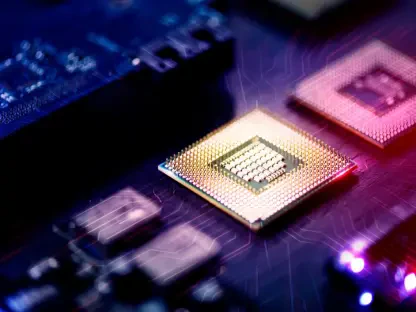As 2024 draws to a close, defense contractors and the federal government face mounting cybersecurity challenges, compelling a reassessment of their security postures and strategies. Recent developments are transforming military operations, cybersecurity measures, and government contracts. The heightened focus on modernizing legacy systems, the threat of AI and commercial spyware, and the implementation of the Cybersecurity Maturity Model Certification (CMMC) 2.0 are shaping the defense landscape. Amid increasing budgets and evolving threats, the readiness of defense contractors to meet these challenges will be crucial.
Increased Cybersecurity Spending and Zero-Trust Architecture
Budget Increases and State-Sponsored Threats
In response to rising cyber threats from state-sponsored actors, the military sector’s cybersecurity budget has surged from $36.9 billion in 2023 to a projected $49.4 billion by 2028. This budgetary increase underscores the growing recognition of the need for robust defenses against sophisticated cyber adversaries. Enhanced funding is aimed at reinforcing cybersecurity protocols across various domains, ensuring a fortified defense against ever-evolving threats. As the financial commitment grows, it will enable more comprehensive initiatives and the deployment of advanced technologies designed to mitigate potential risks.
The escalation of cyber threats is not limited to the theoretical realm; it manifests in real attacks that compromise sensitive information and disrupt operations. These incursions have heightened awareness about the vulnerabilities that exist within the current defense infrastructure. Consequently, the allocated budget must address both immediate and long-term needs, fostering a resilient cybersecurity environment. This increased investment is a clear indicator of the urgency to protect national security interests against malicious actors seeking to exploit weaknesses in defense systems.
Zero-Trust Architecture Adoption
A significant shift towards zero-trust architecture (ZTA) is underway within military networks. This approach aims to minimize vulnerabilities by assuming that threats could exist both inside and outside the network. Implementing ZTA is essential for modernizing legacy infrastructure and enhancing the security posture of defense mechanisms. The zero-trust model operates on the principle of “never trust, always verify,” requiring rigorous authentication and continuous monitoring to ensure network integrity. This paradigm shift reflects a move away from traditional perimeter-based security, which is increasingly ineffective against sophisticated cyber threats.
The integration of ZTA into defense systems involves multiple steps, including the segmentation of networks and the deployment of real-time threat detection tools. By enforcing strict access controls and continuously verifying user identities, organizations can significantly reduce the likelihood of unauthorized access and data breaches. As the demand for robust cybersecurity measures grows, ZTA represents a critical component in fortifying defense networks against potential intrusions and ensuring a resilient defense posture.
Industrial Control Systems Vulnerabilities
Importance of ICS in Public Infrastructure
Industrial Control Systems (ICS) play a vital role not only in military applications but also in the broader U.S. infrastructure. In 2024, the Cybersecurity and Infrastructure Security Agency (CISA) issued 119 ICS-specific advisories, highlighting the persistent vulnerabilities that pose risks to essential public services. These advisories underscore the critical need for heightened security measures to protect ICS from potential cyberattacks that could disrupt vital infrastructure operations. The importance of safeguarding ICS extends beyond national defense, as these systems are integral to sectors such as energy, water, and transportation.
The ongoing emphasis on ICS security reflects the growing recognition of the interconnected nature of modern infrastructures. Cyberattacks targeting these systems can have far-reaching consequences, affecting public safety and economic stability. Consequently, there is a pressing need to develop and implement robust security protocols tailored to the unique vulnerabilities of ICS. This endeavor requires collaborative efforts among government agencies, private sector entities, and cybersecurity experts to ensure comprehensive protection against emerging threats.
Convergence of OT and IT Networks
The increasing interconnectedness of Operational Technology (OT) and Information Technology (IT) networks has expanded the attack surface, making ICS and OT systems prime targets for cyberattacks. This convergence demands heightened vigilance and advanced security measures to protect critical infrastructure operations. As OT systems become more integrated with IT networks, the potential for cyber threats to exploit these connections grows exponentially. The blurring of boundaries between these traditionally separate domains creates new vulnerabilities that malicious actors can exploit to gain unauthorized access or disrupt operations.
Securing the converged OT and IT environments requires a multi-faceted approach that includes network segmentation, real-time monitoring, and incident response planning. By implementing stringent access controls and continuously monitoring for anomalies, organizations can detect and mitigate potential threats before they cause significant damage. The integration of advanced cybersecurity tools and technologies is essential to safeguarding these critical systems against the evolving landscape of cyber threats.
Rising Ransomware Threats
Global Increase in Ransomware Attacks
Ransomware attacks have seen a staggering 74% increase globally in 2023, with key U.S. sectors such as agriculture, defense, government, energy, healthcare, IT, and transportation being particularly targeted. This escalation calls for robust defenses and comprehensive incident response strategies. The rise in ransomware attacks reflects the sophisticated tactics employed by cybercriminals to extort money and disrupt operations. These attacks often involve encrypting critical data and demanding ransom payments in exchange for decryption keys, causing significant operational and financial disruptions.
The increasing prevalence of ransomware underscores the importance of proactive cybersecurity measures, including regular data backups, employee training, and the implementation of advanced threat detection and response systems. Organizations must adopt a multi-layered defense approach to detect and mitigate ransomware threats promptly. Collaboration between private sector entities and government agencies is also crucial to share threat intelligence and coordinate effective responses to ransomware incidents.
Supply Chain Security
The Department of Defense (DoD) emphasizes the importance of securing supply chains against ransomware threats. This focus is reflected in the rigorous cybersecurity practices mandated by the CMMC, aimed at protecting critical data and ensuring operational resilience. The supply chain represents a critical vulnerability in the defense sector, as it comprises numerous interconnected entities, each with its security measures and protocols. Ensuring the integrity and security of the supply chain is essential to prevent disruptions that could compromise national security.
The CMMC framework provides a structured approach to assess and enhance supply chain cybersecurity, requiring contractors to implement specific security controls based on the level of sensitivity of the information they handle. By adhering to the CMMC standards, defense contractors can demonstrate their commitment to cybersecurity and build trust with government agencies. The emphasis on supply chain security highlights the interconnected nature of modern defense operations and the need for a cohesive and comprehensive cybersecurity strategy.
IoT and IIoT Integration Risks
Vulnerabilities of IoT and IIoT Devices
The integration of Internet of Things (IoT) and Industrial Internet of Things (IIoT) devices has increased susceptibility to cyberattacks. The elimination of traditional air gaps has made these devices vulnerable to remote exploits, with potential implications for public safety and military operations. IoT and IIoT devices are often embedded with sensors and connected to networks, enabling real-time monitoring and control of critical infrastructure. However, their connectivity also creates new entry points for cyber threats, which can be exploited to launch attacks and disrupt operations.
The proliferation of IoT and IIoT devices necessitates a robust cybersecurity framework to protect against potential vulnerabilities. Implementing strong authentication mechanisms, encryption, and regular security updates are essential to safeguard these devices. Additionally, continuous monitoring and threat detection are crucial to identify and mitigate potential attacks before they cause significant damage. The interconnected nature of IoT and IIoT devices demands a holistic approach to cybersecurity that encompasses both device-level and network-level security measures.
Threats from Device Exploitation
Engineering workstations bridging IT and OT networks are of particular concern due to their potential to cause physical disruptions in critical infrastructure. Malicious actors exploiting device vulnerabilities can launch various attacks, including ransomware and even chemical alterations in water supplies, necessitating advanced cybersecurity measures. These engineering workstations serve as critical control points for managing and operating OT systems, making them attractive targets for cybercriminals seeking to disrupt operations or extort organizations.
Securing engineering workstations requires implementing stringent access controls, regular security assessments, and real-time monitoring to detect and respond to potential threats. Organizations must also prioritize patch management to ensure that vulnerabilities are promptly addressed. The potential consequences of device exploitation underscore the need for a proactive and comprehensive approach to securing engineering workstations and other critical control points within the OT environment.
Impact of U.S. Elections on Cybersecurity Policy
Policy Shifts and Regulatory Changes
The upcoming U.S. election has the potential to significantly influence cybersecurity strategies for contractors and military organizations. Changes in administration or Congress could result in shifts in policy, funding, and regulatory requirements, impacting the enforcement of cybersecurity regulations like the CMMC. The political landscape plays a crucial role in shaping national cybersecurity priorities and the allocation of resources to address emerging threats. Depending on the election outcomes, there could be changes in the focus and approach towards safeguarding critical infrastructure and defense operations.
Election-related policy shifts may lead to new regulations or amendments to existing ones, requiring defense contractors to adapt their cybersecurity practices accordingly. Staying informed about potential regulatory changes is essential for contractors to remain compliant and ensure the security of their operations. The dynamic nature of the political environment necessitates agility and preparedness to navigate potential changes in cybersecurity policy.
Budget Allocations and Technology Priorities
Depending on the political landscape, budget allocations could pivot towards advanced technologies such as AI and quantum computing, altering the focus and approach towards cyber threats from adversarial nations. These potential shifts underscore the importance for contractors to remain adaptable and informed. Investment in emerging technologies can enhance cybersecurity capabilities, providing advanced tools for threat detection, prevention, and response. The prioritization of AI and quantum computing reflects the evolving nature of cyber threats and the need for innovative solutions to address these challenges.
For defense contractors, staying abreast of technological advancements and budgetary shifts is crucial to maintaining a competitive edge and ensuring robust cybersecurity measures. The potential for increased funding in advanced technologies highlights the importance of continuous research and development to stay ahead of adversaries. Embracing innovation and adapting to changing technological priorities will be key to successfully navigating the evolving cybersecurity landscape.
International Relations and Cybersecurity
Influence of Global Dynamics
International relations and policy changes have broad implications for cybersecurity, particularly concerning nation-state cyber threats. These evolving dynamics impact military preparedness and contractor security postures, highlighting the need for a cohesive cybersecurity strategy that aligns with global developments. The interplay between international relations and cybersecurity necessitates a comprehensive understanding of geopolitical factors that influence cyber threats. Nation-state actors often exploit geopolitical tensions to launch cyberattacks, targeting critical infrastructure and defense systems to achieve strategic objectives.
Defense contractors must stay informed about global developments and potential threats to adapt their cybersecurity strategies accordingly. Collaboration with international partners and participation in global cybersecurity initiatives can enhance the collective defense against nation-state cyber threats. A cohesive and well-coordinated approach to cybersecurity is essential to address the complex and evolving landscape of global cyber threats.
Readiness and Adaptability
As 2024 nears its end, defense contractors and the federal government are grappling with escalating cybersecurity challenges, prompting a reevaluation of their security strategies. Recent shifts are reshaping military operations, cybersecurity protocols, and government contracts. A growing emphasis on updating outdated systems, coupled with the threats posed by AI and commercial spyware, significantly impacts the defense arena. One major development is the implementation of the Cybersecurity Maturity Model Certification (CMMC) 2.0, a framework designed to enhance the security posture of defense contractors.
Simultaneously, increased defense budgets reflect the urgency of addressing these modern threats. The evolving landscape necessitates that defense contractors not only comply with stricter cybersecurity measures but also remain agile in response to new challenges. The readiness of these contractors to adapt and fortify their defenses will be pivotal in safeguarding national security. As technology continues to advance, the synergy between government agencies and private defense contractors will be essential in mitigating risks and ensuring robust protection against sophisticated cyber threats.









